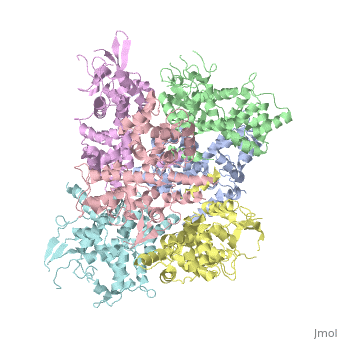Calcium uptake protein 1
From Proteopedia
(Difference between revisions)
| Line 1: | Line 1: | ||
==Structure)== | ==Structure)== | ||
<StructureSection load='4NSC' size='340' side='right' caption='Caption for this structure' scene=''> | <StructureSection load='4NSC' size='340' side='right' caption='Caption for this structure' scene=''> | ||
| - | |||
Micu 1 (Mitochondrial Calcium Uptake 1) is a key regulator of mitochondrial calcium uniporter (MCU) required to increase calcium uptake by MCU when cytoplasmic calcium is high. | Micu 1 (Mitochondrial Calcium Uptake 1) is a key regulator of mitochondrial calcium uniporter (MCU) required to increase calcium uptake by MCU when cytoplasmic calcium is high. | ||
It also regulates glucose-dependent insulin secretion in pancreatic beta-cells by regulating mitochondrial calcium uptake. | It also regulates glucose-dependent insulin secretion in pancreatic beta-cells by regulating mitochondrial calcium uptake. | ||
== Function == | == Function == | ||
| - | + | MICU 1 is a regulator of Ca 2+ uptakes in mitochondria. To do this regulation, it can sense the concentration of calcium in the cytosol of the cell thanks to 2 EF-hand domains. It mainly acts on MCU which is a transmembrane uniporter channel located on the inner membrane of the mitochondria. To interact with MCU, MICU1 has to be linked to MICU2 (a paralogue protein). The entire complex of Ca2+ regulation is MICU1/MICU2/MCU/EMRE. EMRE is a protein which is required for the interaction of MCU with MICU1/MICU2. | |
| - | It mainly acts on MCU | + | When it is not linked to Ca2+ it has an hexameric conformation. In this conformation MICU 1 silences the activity of MCU/EMRE and stop the Ca 2+ from entering the mitochondria by blocking the entrance of the channel. |
| - | When | + | When there is a lot of calcium in the intermembrane so in the cytoplasm, Ca2+ binds to MICU1, then it changes its conformation, separates into multiple homooligomers that results in opens the “gate” in front of the MCU channel, letting the calcium enter into the matrix. |
| - | When | + | |
== Disease == | == Disease == | ||
| - | + | If MICU1 gene is modified, Ca2+ can be load in higher concentration in the mitochondry resulting Myopathy with extrapyramidal signs (MPXPS). This is an autosomal recessive disorder characterized by early-onset proximal muscle weakness with a static course and moderately to grossly elevated serum creatine kinase levels accompanied by learning difficulties. Most patients develop subtle extrapyramidal motor signs that progress to a debilitating disorder of involuntary movement with variable features, including chorea, tremor, dystonic posturing and orofacial dyskinesia. Additional variable features include ataxia, microcephaly, ophthalmoplegia, ptosis, optic atrophy and axonal peripheral neuropathy. | |
| - | + | ||
== Relevance == | == Relevance == | ||
Revision as of 14:34, 28 January 2016
Structure)
| |||||||||||

